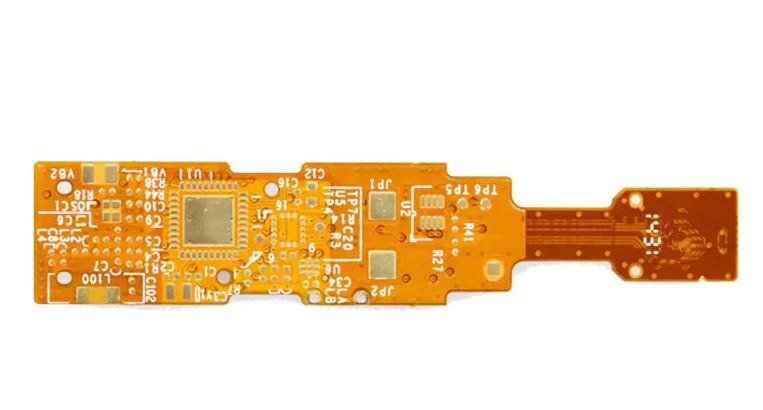In the ever-evolving world of electronics, the demand for smaller, lighter, and more flexible circuitry is on the rise. This demand has driven the development of cutting-edge technologies, including Flexible Printed Circuit Boards (Flex PCBs), which play a pivotal role in the design and manufacturing of modern electronic devices. Among the various types of Flex PCBs, those incorporating Polymide (PI) as the core material and PTFE (Polytetrafluoroethylene) as the coverlay are gaining prominence. In this article, we will delve into the fascinating world of Flexible PCBs, focusing on their materials, construction, and surface treatment.
Materials: Polymide (PI) and Coverlay
Flexible PCBs are constructed using a combination of materials designed to provide the necessary flexibility, durability, and electrical conductivity. One of the primary materials used in Flex PCBs is Polymide, commonly referred to as PI. PI is known for its excellent thermal stability, electrical insulation properties, and remarkable flexibility. These characteristics make it an ideal choice as the core material for Flexible PCBs.
In addition to the PI core, Flex PCBs also feature a coverlay, which is typically made from PTFE (Polytetrafluoroethylene). PTFE is renowned for its exceptional electrical insulation capabilities, high-temperature resistance, and chemical inertness. The coverlay serves as a protective layer, shielding the underlying circuitry from environmental factors such as moisture, dust, and mechanical stress.
Board Thickness
Flex PCBs are available in a variety of thicknesses, with 0.2mm being a common choice. The selection of board thickness depends on the specific requirements of the application. Thinner Flex PCBs are often favored in applications where space constraints are critical, while thicker ones may be chosen for enhanced durability and structural support.
Construction
The construction of Flex PCBs involves layering and bonding the core material (PI) with the coverlay (PTFE) to create a flexible, yet robust substrate for circuitry. This layered structure allows for the flexibility required in applications where traditional rigid PCBs would not be suitable. The core material provides the necessary mechanical support, while the coverlay ensures protection and insulation.
The flexibility of Flex PCBs is achieved by minimizing the thickness of the PI core and optimizing the bonding process between the core and coverlay. This delicate balance results in a circuit board that can bend and conform to various shapes without compromising its structural integrity.
Surface Treatment: Immersion Gold
Surface treatment is a critical aspect of Flex PCB manufacturing, as it directly impacts the performance and reliability of the circuitry. One of the most commonly used surface treatments for Flex PCBs is Immersion Gold.
Immersion Gold, also known as ENIG (Electroless Nickel Immersion Gold), is a process in which a thin layer of nickel is deposited onto the exposed copper traces of the Flex PCB, followed by a layer of gold. This dual-layered finish provides several advantages:
- Excellent Solderability: The gold surface ensures that components can be easily soldered to the PCB, promoting reliable electrical connections.
- Corrosion Resistance: Gold is highly resistant to corrosion, making it an ideal choice for Flex PCBs that may be exposed to harsh environments.
- Smooth Surface: Immersion Gold provides a smooth and flat surface, which is crucial for fine-pitch components and high-frequency applications.
- Long-Term Reliability: The combination of nickel and gold layers ensures long-term stability and reliability of the Flex PCB.
Applications
The versatility of Flex PCBs, especially those featuring a PI core and PTFE coverlay with Immersion Gold surface treatment, has led to their adoption in a wide range of applications. Some notable examples include:
- Consumer Electronics: Flex PCBs are used in smartphones, tablets, wearables, and other portable devices to enable compact and flexible designs.
- Automotive Industry: In modern vehicles, Flex PCBs are employed in control systems, infotainment systems, and sensors due to their ability to withstand vibrations and tight spaces.
- Medical Devices: Flex PCBs play a crucial role in medical equipment such as pacemakers, MRI machines, and diagnostic devices, where reliability and miniaturization are paramount.
- Aerospace and Defense: The aerospace and defense sectors utilize Flex PCBs for their lightweight and space-saving properties in avionics, satellites, and communication systems.
Conclusion
Flexible Printed Circuit Boards have revolutionized the way electronic devices are designed and manufactured. With materials like Polymide (PI) for flexibility, PTFE coverlay for protection, and Immersion Gold surface treatment for reliability, Flex PCBs have become indispensable in various industries. As technology continues to advance, we can expect further innovations in the field of Flex PCBs, driving the development of even smaller and more flexible electronic devices
